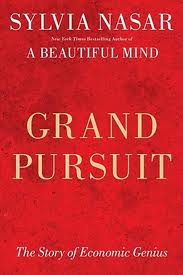A Not-So-Grand Pursuit
Economics? Numbers and graphs spring to mind. As for economists, the image of dully older men in bow ties lecturing dominates. There are good reasons it is the most dismal of sciences. Silvia Nasar, a successful journalist and author (A Beautiful Mind was her last book) struggles to challenges these stereotypes in her latest book, Grand Pursuit: the story of economic genius. it’s a valiant struggle, but not wholly successful – it’s not really clear why she assigned herself the task.
Grand Pursuit is a social history of economists, from the early Victorian years in England through post-World War II in the United States. Nasar’s key figures include Karl Marx, Alfred Marshall, Beatrice Potter, Irving Fisher, Joseph Schumpeter, John Maynard Keynes, Friedrich von Hayek, Webb, Joan Robinson, Milton Friedman, Paul Samuelson, and Amartya Sen. It is an interesting list. They are important thinkers and policy makers, to be sure, but it would be difficult to argue that there are the most influential economists. It is an argument that Nasar does not advance.
Nasar effectively sketches the lives of these men and women, highlighting their key works and their lives. Relationships figure prominently, as do breakdowns, health scares, and drama. The biographies are not complete, however; we only learn particular segments without a deeper understanding of context. Equally frustrating, Nasar never squares the circle with these people. A social history should not require ongoing reference to Wikipedia.
A deeper frustration, however, is that the ideas of these economists is never fully fleshed out. Particular aspects of their intellectual priorities receives attention, but it would be impossible to provide a high level synopsis of the key ideas of any of these men and women. More importantly, the development of economics as a professional field of study and its relationship to politics and history is bypassed. That, in many ways, is the key to understanding the relative impact of these individuals. It is missing, sadly, even though the components of that theme occasionally surface in the narrative.
What remains? A well written social history of a select group of people who played an important role in economic thought over one hundred years. Good social history, however, demands careful attention to context. Nasar’s book may started with an interesting conceit – the lives of economists – but she never created a structure in which that focus could succeed.